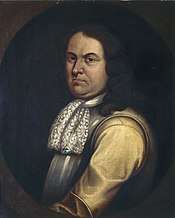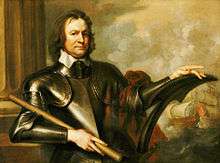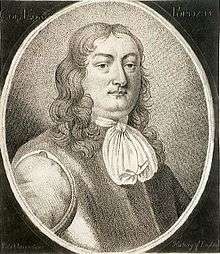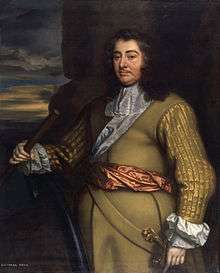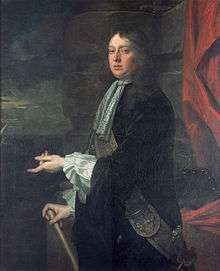General at sea
The rank of general at sea (occasionally referred to as "general of the fleet"[1]), was the highest position of command in the English Parliamentary Navy (later the Navy of the Commonwealth of England, Scotland and Ireland), and approximates to the current rank of admiral. Alongside others, the generals at sea were also appointed as Commissioners for the Admiralty and Navy.[1]
| General at Sea | |
|---|---|
.svg.png) Flag of the General at Sea | |
| Country | |
| Service branch | Parliamentary Navy |
| Equivalent ranks | Admiral |
The generals at sea were referred to both by the title of 'general' and by their former army ranks interchangeably.[2] Today, the title 'admiral' is also commonly – if incorrectly – used.
The generals at sea
In February 1649, within a month of the execution of Charles I, the Council of State decided to put the office of Lord High Admiral into commission, and Colonel Robert Blake, Colonel Edward Popham and Colonel Richard Deane were appointed by Parliament as the first generals at sea[3] and Commissioners for the Admiralty and Navy.[4]
After Popham's death in 1651 he was succeeded in 1652 by General George Monck.[5]
Deane was recalled to serve in the army in May 1651, before resuming his post as general at sea in 1652, but was killed at the start of the Battle of the Gabbard on 1 June 1653.[6]
Following the death of Deane, Blake and Monck continued to serve alone until 3 December 1653, when Parliament decided to increase the number of generals at sea to four, with a quorum of two, appointing Major-General John Desborow and Vice-Admiral William Penn (who had been recommended by Monck[7]) to serve alongside Blake and Monck as generals at sea, with all four also serving as Commissioners for the Admiralty and Navy along with Colonel Philip Jones, Colonel John Clerk, John Stone, Major William Burton, Vincent Gooking and Lieutenant-Colonel Kelsey.[1]
Penn's naval career was suspended after the failure to successfully execute the Western Design against Spanish colonies in the West Indies in 1655, which resulted in his temporary imprisonment in the Tower of London.[7]
In January 1656, Edward Montague was appointed general at sea.[8][9]
Blake continued to serve until his death at sea on 7 August 1657,[4] and Montagu until 1665.[8]
Rank insignia and personal flag
Included:[10]
Generals at Sea in command of the red squadron
.svg.png) Flag of the commonwealth flown at the main mast.
Flag of the commonwealth flown at the main mast..png) Red ensign flown at the aft mast.
Red ensign flown at the aft mast.
Generals at Sea in command of the white squadron
.svg.png) Flag of the commonwealth flown at the main mast.
Flag of the commonwealth flown at the main mast. White ensign flown at the aft mast.
White ensign flown at the aft mast.
Generals at Sea in command of the blue squadron
.svg.png) Flag of the commonwealth flown at the main mast.
Flag of the commonwealth flown at the main mast. Blue ensign flown at the aft mast.
Blue ensign flown at the aft mast.
References
- "House of Commons Journal Volume 7: 3 December 1653". Journal of the House of Commons: volume 7: 1651-1660. Institute of Historical Research. 1802. Retrieved 7 December 2011.
- Thomas Birch (editor) (1742). "State Papers, 1650: July-September". A collection of the State Papers of John Thurloe, volume 1: 1638-1653. Institute of Historical Research. Retrieved 7 December 2011.CS1 maint: extra text: authors list (link)
- Blake Museum staff. "Who was Robert Blake?". Blake Museum. Archived from the original on 2 October 2011. Retrieved 7 December 2011.
- Plant, David (18 April 2010). "Robert Blake 1599-1657". British Civil Wars & Commonwealth.
- Plant, David (30 May 2007). "George Monck 1608-70". British Civil Wars & Commonwealth.
- Plant, David (7 February 2008). "Richard Deane, 1610-53". British Civil Wars & Commonwealth.
- Plant, David (7 November 2005). "William Penn, c.1621-70". British Civil Wars & Commonwealth.
- "The History of Edward Montagu". Montagu's Regimental Website. Archived from the original on 26 February 2012. Retrieved 7 December 2011.
- Plant, David (2 June 2010). "Timeline 1656". British Civil Wars & Commonwealth.
- Perrin, W. G. (William Gordon) (1922). "Admirals: Flags of Command". British flags, their early history, and their development at sea; with an account of the origin of the flag as a national device. Cambridge, England: Cambridge : The University Press. pp. 73-109.
